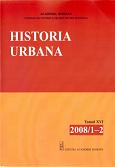Cele mai vechi sigilii ale oraşului Piteşti, imprimate pe două acte inedite din prima jumătate a secolului al XVII-lea
The Oldest Seals of Piteşti Printed on Two Inedited Documents from the First Half of the 17th Century
Author(s): Marius PăduraruSubject(s): History
Published by: Editura Academiei Române
Keywords: Piteşti; seals; monastery; maps;
Summary/Abstract: This paper introduces in the scientific circuit two seals of Piteşti, printed on two inedited documents. The first seal, printed on a document which no longer preserves the year of its emission and which we dated about the 23rd of November 1623 − before the 30th of March 1634, belongs to a seal matrix which we consider to be made at the end of the 15th century − the beginning of the second half of the 16th century. The pattern of the seal, whose stamp was preserved on the document from the 30th of the March 1634, must have been made between the third decade of the 17th century and the first four years of the fourth decade of the 17th century. The older circular seal (D = 22 mm) printed in smoke has the aspect conformable to the canons of the epoch's escutcheon, because it has on the emblem a Polish shield, which has as an artificial heraldic figure, a croci patenti or la croix patée (a paw like cross whose arms open towards the ends) combined with a Greek cross. The inscription placed between two linear circles includes the legend written in Slavonic letters: "This <is> the seal <from> Piteşti". The second seal is circular (D = 27 mm) and printed in smoke, too. It contains an emblem which also has a croci patenti, which includes specific elements of the Latin cross and of the Cross of Malta (la croix de Malte). There are differences between the two seals. Thus the artificial heraldic figure of the second one is framed by two natural figures: „an eight rays rising sun”, to dextra, and a reversed half moon (a figurative new moon) to senestra. The legend is written in Slavonic and placed in inscription between two continuous circles: „This <is> the seal from Piteşti”. We consider the two religious seals to be related to an important monastic place of the locality. The existence of this monastery was marked in several cartographic works from the second half of the 16th century until the end of the 17th century (The Map Transylvania of Ioan Sambucus – 1566; The Map Moldavia, Valachia et Tartariae Pars of Dominicus Custodis – 1596; The Map Descritione delli principati della Moldavia e Valachia of Giacomo Cantelli da Vignola – 1686). It also appears in the description made by the bishop Petru Bogdan Bakšić, bishop of Gallipolis and the first catholic archbishop of Bulgaria, in 1642, when he visited the town. The seals presented in these lines are the oldest historical sources of this kind related to the history of Pitesti. Their identification represents an important step forward in studying the medieval past of Pitesti but is, at the same time, a diverse problem some of its aspects being only partially cleared up at present.
Journal: Historia Urbana
- Issue Year: XVI/2008
- Issue No: 1+2
- Page Range: 173-188
- Page Count: 16
- Language: Romanian
- Content File-PDF

